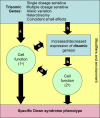Understanding the basis for Down syndrome phenotypes
- PMID: 16596169
- PMCID: PMC1420680
- DOI: 10.1371/journal.pgen.0020050
Understanding the basis for Down syndrome phenotypes
Abstract
Down syndrome is a collection of features that are caused by trisomy for human Chromosome 21. While elevated transcript levels of the more than 350 genes on the chromosome are primarily responsible, it is likely that multiple genetic mechanisms underlie the numerous ways in which development and function diverge in individuals with trisomy 21 compared to euploid individuals. We consider genotype-phenotype interactions with the goal of producing working concepts that will be useful for approaches to ameliorate the effects of trisomy.
Conflict of interest statement
Competing interests. The authors have declared that no competing interests exist.
Figures


Similar articles
-
Down syndrome--a gene dosage disease caused by trisomy of genes within a small segment of the long arm of chromosome 21, exemplified by the study of effects from the superoxide-dismutase type 1 (SOD-1) gene.APMIS Suppl. 1993;40:71-9. APMIS Suppl. 1993. PMID: 8311993 Review.
-
Chromosome 21 and down syndrome: from genomics to pathophysiology.Nat Rev Genet. 2004 Oct;5(10):725-38. doi: 10.1038/nrg1448. Nat Rev Genet. 2004. PMID: 15510164 Review.
-
Using mouse models to explore genotype-phenotype relationship in Down syndrome.Ment Retard Dev Disabil Res Rev. 2007;13(3):207-14. doi: 10.1002/mrdd.20164. Ment Retard Dev Disabil Res Rev. 2007. PMID: 17910089 Review.
-
Genetic mechanisms involved in the phenotype of Down syndrome.Ment Retard Dev Disabil Res Rev. 2007;13(3):199-206. doi: 10.1002/mrdd.20162. Ment Retard Dev Disabil Res Rev. 2007. PMID: 17910086 Review.
-
Genomic determinants in the phenotypic variability of Down syndrome.Prog Brain Res. 2012;197:15-28. doi: 10.1016/B978-0-444-54299-1.00002-9. Prog Brain Res. 2012. PMID: 22541286 Review.
Cited by
-
Assessment of emotional intelligence in adults with down syndrome: Psychometric properties of the Emotional Quotient Inventory.PLoS One. 2020 Jul 22;15(7):e0236087. doi: 10.1371/journal.pone.0236087. eCollection 2020. PLoS One. 2020. PMID: 32697810 Free PMC article.
-
Whole genome analysis reveals aneuploidies in early pregnancy loss in the horse.Sci Rep. 2020 Aug 7;10(1):13314. doi: 10.1038/s41598-020-69967-z. Sci Rep. 2020. PMID: 32769994 Free PMC article.
-
Mutation accumulation and developmental lineages in normal and Down syndrome human fetal haematopoiesis.Sci Rep. 2020 Jul 31;10(1):12991. doi: 10.1038/s41598-020-69822-1. Sci Rep. 2020. PMID: 32737409 Free PMC article.
-
Integrated Quantitative Neuro-Transcriptome Analysis of Several Brain Areas in Human Trisomy 21.Genes (Basel). 2022 Apr 1;13(4):628. doi: 10.3390/genes13040628. Genes (Basel). 2022. PMID: 35456434 Free PMC article.
-
Transcriptomic analysis of stem cells from chorionic villi uncovers the impact of chromosomes 2, 6 and 22 in the clinical manifestations of Down syndrome.Stem Cell Res Ther. 2023 Sep 23;14(1):265. doi: 10.1186/s13287-023-03503-4. Stem Cell Res Ther. 2023. PMID: 37740230 Free PMC article.
References
-
- Morris JK, Wald NJ, Watt HC. Fetal loss in Down syndrome pregnancies. Prenat Diagn. 1999;19:142–145. - PubMed
-
- Spencer K. What is the true fetal loss rate in pregnancies affected by trisomy 21 and how does this influence whether first trimester detection rates are superior to those in the second trimester? Prenat Diagn. 2001;21:788–789. - PubMed
-
- Hassold T, Hunt P. To err (meiotically) is human: The genesis of human aneuploidy. Nat Rev Genet. 2001;2:280–291. - PubMed
-
- Ferencz C, Neill CA, Boughman JA, Rubin JD, Brenner JI, et al. Congenital cardiovascular malformations associated with chromosome abnormalities: An epidemiologic study. J Pediatr. 1989;114:79–86. - PubMed
-
- Cohen WI. Health care guidelines for individuals with Down syndrome: 1999 revision. Down Syndrome Quarterly. 1999;4:1–16.
Publication types
MeSH terms
Grants and funding
LinkOut - more resources
Full Text Sources
Medical

